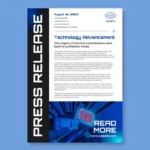The recently released artificial intelligence (AI) action plan of White House in America has outlined 90 policy actions aimed at putting the USA at the leading position in facilitating AI-driven innovation and advancements. With the AI infrastructure expansion 2025 plan for the country, the Trump Administration has taken a step further in accelerating AI-powered developments in the country. In his executive order for the same, the US President Donald Trump has stated that, “Today, a new frontier of scientific discovery lies before us, defined by transformative technologies such as artificial intelligence… Breakthroughs in these fields have the potential to reshape the global balance of power, spark entirely new industries, and revolutionize the way we live and work. As our global competitors race to exploit these technologies, it is a national security imperative for the United States to achieve and maintain unquestioned and unchallenged global technological dominance. To secure our future, we must harness the full power of American innovation.”
A Step Towards Winning the AI Race
The US is aiming to win the race to achieve global dominance in artificial intelligence. By signing Executive Order 14179, Trump has taken a strategic and decisive step toward “Removing Barriers to American Leadership in Artificial Intelligence,” encouraging America to retain its dominance in this global race and creating an AI Action Plan.
Seizing victory in the global AI race, the nation sets its sights on a bold new chapter of progress, security, and economic strength. With AI as their engine, Americans are poised to open doors to breakthroughs that once seemed out of reach. From unearthing novel materials to pioneering innovative ways to harness energy, this technological leap sparks a modern industrial revolution.
The achievement promised a better future for education, communication, and media. Enabling new intellectual achievements, the AI action plan will make breakthroughs in scientific and mathematical theory, ushering in a renaissance of digital and physical art.
The Revolutionary AI Action Plan: Towards a Future Full of Potentials
The White House’s Action Plan stands on the strong pillars of infrastructure, innovation, security, and international diplomacy. Trump underscored the urgent need for the nation to outpace its rivals by driving faster and broader innovation in developing and deploying AI-powered technology across all sectors. Demolishing nonessential regulatory barriers for the private sector to drive AI-powered innovation, this plan paves the path for companies to embrace the technology. America’s President emphasized the need for building and maintaining an extensive AI infrastructure and the energy to power it.
Pillar 1: Accelerating AI Innovation
As stated by the plan, America must have the most powerful AI system in the world, making way for the creative and transformative application of these systems. To achieve this goal, the Federal government must create conditions for private-sector-driven innovation to flourish. Removing the red tape and onerous regulations from the private sector is the first step to take in this endeavor. Some policy recommendations include launching a Request for Information from businesses by the Office of Science and Technology Policy, “Unleashing Prosperity Through Deregulation,” and several more.
Open-source and open-weight AI models are made available by developers for anyone in the world to download and modify. America must ensure leading open models founded on American values. Today, the drawback of harnessing the full potential of AI is not limited to the availability of tools, models, or applications. It is the slow adoption of AI within large organizations. One of the recommended policy actions in this regard includes establishing regulatory sandboxes or AI Centers of Excellence throughout the country. Prioritizing AI skill development to empower workers in the age of AI is another approach to foster AI-powered innovation.
Increasing investment in AI-enabled science would unlock more opportunities for transformation in this sector. Through Federal partners, investors must support automated cloud-enabled labs, and researchers should be incentivized to release high-quality datasets. Accelerating investment in AI interoperability, control, and breakthroughs will better equip the country to explore its full potential in high-stakes national security. By accelerating AI adoption in the government sector, its adaptability must be increased throughout the country.
Pillar 2: Building American AI Infrastructure
The Trump Administration has made unparalleled progress in reforming the technological infrastructure in the USA. To create streamlined permitting for data centers, the Trump-led government has recommended establishing new Categorical Exclusions under NEPA to encompass data center-related actions that have the least environmental impact. Making federal land available for data center construction and the construction of power generation infrastructure for those centers is crucial for successfully building the AI infrastructure in the country.
Developing a grid to keep pace with the rapid AI innovation practices is another step toward building the infrastructure. The US electric grid must be expanded to enhance its capability to weather the challenges associated with it. Stabilizing the existing grid, optimizing the grid resources, prioritizing the interconnection of reliable power sources, and creating a strategic blueprint to navigate the complex energy landscape are required for upgrading the grid.
The US government emphasizes building high-security data centers for military and intelligence community use through the AI data center deployment 2025 program. The spread of AI technologies requires detailed planning to ensure that if systems fail, the impacts on critical services or infrastructure will be minimal.
Pillar 3: Leading in Security and International Diplomacy
To help America win the AI race, it must do more than promote AI within its own borders. By exporting AI-powered hardware, software, models, applications, and standards, the US can address global demand for AI. The country should establish a program within DOC to gather proposals from industry for AI export packages. It must also strengthen AI compute export control enforcement, close loopholes in semiconductor manufacturing export controls, align protection measures worldwide, invest in biosecurity, and ensure the government leads in evaluating national security risks in frontier models.
We, at The CEO Views, explore the potential of AI through our write-ups, helping our readers keep themselves informed about the latest trends and advancements in the technology. As a significant business media publication, we also cover several industries and their approaches to embracing modern technologies.










